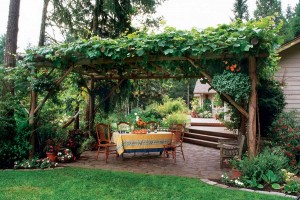
The vegetable garden is just one aspect of your total landscape plan.
Many people, me included, think of vegetable produce when you say garden. But that’s not really true for most of us. Our lifestyles place us in urban or suburban settings more often than not where aesthetics, appearance, ambiance, are just as if not more important than any other aspect of planning your garden. Just like architectural design for the home itself. We live there. We eat, sleep and entertain there. We not only live inside our homes but our lifestyles take us outside our home into our landscape as well. So we want it to look good and be good while serving the way we want to live.
So here are a few things for you to consider as you begin to think about just how you and your family will use and enjoy the space around your home—you know, things like:
- Outdoor living and entertainment—barbecuing, etc.,
- Children’s playground—swings, slides, etc.,
- Swimming pool,
- Zen garden for meditation,
- Water features like a pond, waterfall, etc.,
- Habitat for birds and wildlife,
- Flowers and herbs for mind, eye, kitchen and nose,
- Flowers for bees, color and conversation,
- Shrubs and hedges for privacy and/or outdoor space definition,
- Edible perennials such as apples, peaches, pears, berries, nuts, asparagus, rhubarb, etc.. These can all be a part of your permanent landscape,
- Annual and seasonal vegetables for your table,
- Culinary herbs for your kitchen,
- If you can think of more, let me know.
A total landscape plan will typically be made of of several gardens. For example: you may have an “entry garden” forming an artistic and appealing approach to your front home entry. Other gardens might address topographic features such as embankments, large trees, rocks, etc. While still others will enhance special use spaces for privacy screening, recreation and outdoor living.
Since you want your food garden to fit within a greater overall view and use of your property, it must look right and be right to meet your specific purposes and the needs of the particular plants you intend to grow.
Some of your food plants may be perennials like fruit trees, nut trees, berry canes, rhubarb or asparagus. These plants are best suited for permanent parts of your landscape and don’t need to use up space in your vegetable growing areas.
A website I really like (and I don’t know her personally or receive any remuneration from her) is: edible-landscape-design.com. Here’s another pretty good website. http://www.the-landscape-design-site.com/gardenstyles/
Your total landscape design will be unique because of your own very unique lifestyles, dreams, wants, needs, desires and your topographical, geographical and climate zone considerations.
I prefer to keep things as close to native as possible. For one thing, it looks out of place to see a palm tree in a northern clime. But the most important reason is sustainability. Plants native to your growing area have adapted to your local conditions and will naturally be happier and healthier.
Edible landscapes are growing increasingly popular as people become more interested in utilizing and caring for their environment while experiencing a superior lifestyle quality. Both attractiveness and bountiful food production can result from an edible landscape with a little thoughtful planning.
Think about perennials, annuals and seasonals in your edible landscape. Your perennials would normally be planted as backdrops or hedges because they’re more permanent and generally grow to taller heights. They could also represent island or highlight features or collages drawing attention to a topography, stone outcropping, building, wall or tree such as a tall-growing nut tree.
Asparagus comes to mind as a backdrop or screen although you will want to plan for access to it for early spring harvesting. Other edgings and permanent edibles such as blackberries, raspberries, grapes and tall-growing cane or vining plants will need to be situated for easy access during harvest while blending appropriately with the overall garden design theme. Situate your fruit or nut trees in open spaces for both planned shade and attractive appearance.
While some herbs such as rosemary, can be grown as a hedge in some climates, I prefer to grow mine in pots on my back patio for handy access to the kitchen.
The next article will talk about planning your vegetable garden. If you want to get a jump on that topic here’s an excellent training video series that I like a lot.<a href=”http://72a2d-fo33984t77kguj1m3qfi.hop.clickbank.net/?tid=WFG” target=”_top”>Click Here!</a>
Until next time,
Happy Gardening 🙂